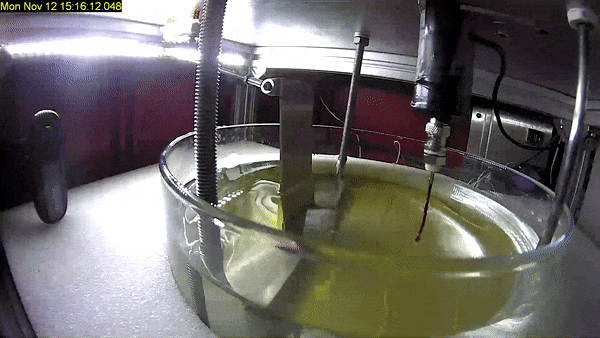
Image:
What might look like jelly being stirred is actually water subjected to 20 times normal Earth gravity within ESA’s Large Diameter Centrifuge – as part of an experiment giving new insight into the behavior of wave turbulence.
This research, led by Stéphane Dorbolo of University of Liège and Eric Falcon of CNRS and University of Paris, has been published in the prestigious Physical Review Letters .
Wave turbulence occurs anywhere where a set of random waves interact with each other – from the ocean to the atmosphere, or in plasmas – but the exact mechanisms behind it are only dimly understood. For surface waves on a liquid, gravity dominates the behavior at low frequencies, while ‘capillary action’ based on surface tension becomes more important at high frequencies.
To increase the range of frequencies where waves are dominated by gravity, the researchers conducted their experiment in the ESA’s Large Diameter Centrifuge (LDC ) where they can create effective gravity levels up to 20 times that of Earth’s gravity.
Within this extended range, the result was a surprise: the typical timescales of wave interactions and dissipation did not depend of the wave frequency, as predicted theoretically.
Instead these timescales are set by the longest available wavelength within the system – namely the size of the container the waves occur within, an effect that current wave turbulence theories does not take into account.
Prof. Falcon explains: “This result suggests that ‘container’ size needs to be considered in studies of water waves within an ocean—as well as atmospheric waves on Earth and magnetically confined plasma waves as in fusion experiments.
“Notably, this experiment serves to complete the scientific picture of how gravity has an impact on surface wave turbulence, because tuning the gravity level to an opposing low value has already been performed in experiments in zero-G parabolic flights in 2009 and more recently aboard the International Space Station in 2019 . This has allowed us to successfully observe pure capillary wave turbulence with no contribution from gravity.”
Operating within a sci-fi style white dome, the LDC is an 8-m diameter four-arm centrifuge that gives researchers access to a range of hypergravity up to 20 times Earth gravity for weeks or months at a time. At its fastest, the centrifuge rotates at up to 67 revolutions per minute, with its six gondolas placed at different points along its arms weighing in at 130 kg, and each capable of accommodating 80 kg of payload.
The LDC was made available for this experiment through the Continously Open Research Announcement of the SciSpace Programme , supported by ESA’s Directorate of Human and Robotic Exploration.
Comments are closed.